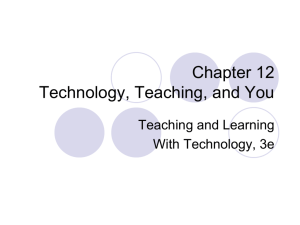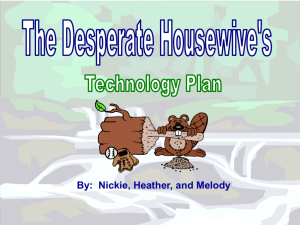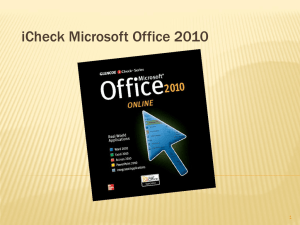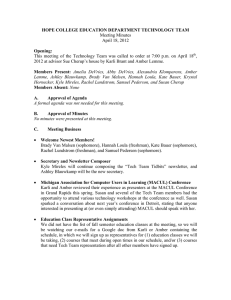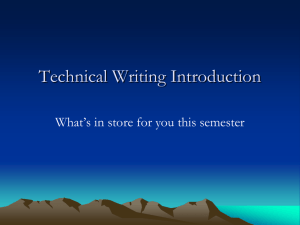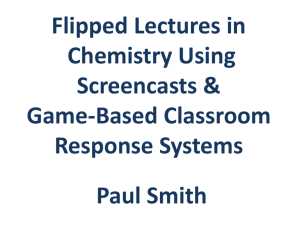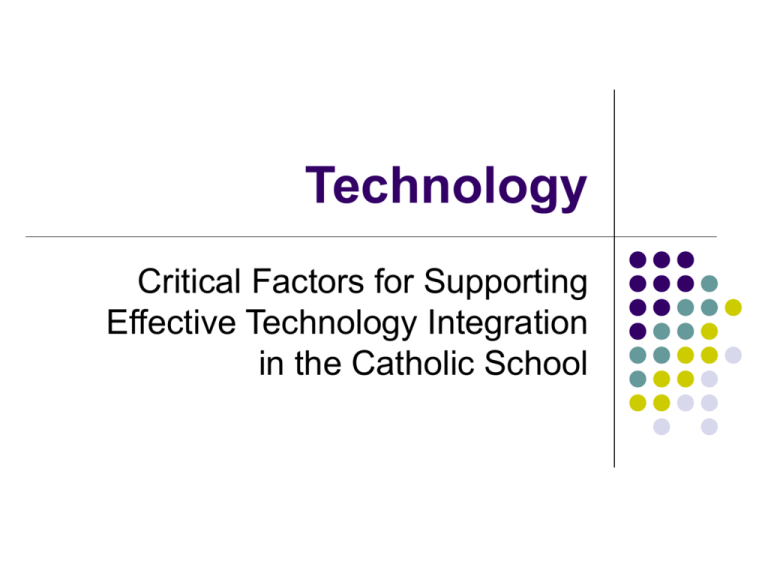
Technology
Critical Factors for Supporting
Effective Technology Integration
in the Catholic School
What do we look for?
Stable and robust infrastructure to safely and
securely manage user demands, necessary
functions and storage needs;
Availability, accessibility and reliability of hardware;
Adequate productivity and educational software or
other solutions to meet both administrative and
academic needs;
Clear roles and responsibilities to ensure coverage
of technical and instructional needs;
What do we look for?
An active Technology Committee with membership
from a variety of stakeholders;
Existence of a three to five-year comprehensive
technology plan;
A school website that provides a positive web
presence to market the school, enhances
communication, and takes advantage of
opportunities which support the integration of
technology into the curriculum;
A clear vision for technology integration.
Infrastructure, Hardware &
Software
What are the common areas that are overlooked that can make
the difference for a Catholic school?
Building or physical plant considerations such as
inadequate electrical infrastructure to support expanded
technology use;
Ensuring working backup and disaster recovery
procedures;
Effective anti-virus and filtering programs;
Maintaining up to date inventories of hardware and
software to assist with acquisition, upgrade and
replacement planning;
Standardization of hardware and software to assist with
regular maintenance and upgrade procedures.
Staffing Models:
Key Personnel
Who can see and manage the “big picture?”
Educational uses of technology;
Administrative uses of technology;
Overall understanding of technical considerations.
Who will work directly with teachers or arrange for
solutions to this need?
Who will communicate effectively with all
constituencies?
Who will actively participate in identifying and
assisting with the completion of grant applications?
Staffing Models: Provision for
Technical Support
This role can be managed by on-site or offsite expertise;
As technology increases in complexity,
ensuring that a skilled individual can resolve
problems quickly as well as provide insight
into future needs is imperative;
1:1 programs require a lot of on-site support;
Mixing this role with teaching is quite often
counter-productive.
The Technology Committee
Membership: all stakeholders!
Administrators, teachers, board, parents,
community members with expertise in
technology:
Big Committee Work: vision, research, sounding
board, etc.
Small Committee Work: Curriculum specifics,
product demonstrations, etc.
The Technology Committee:
Not Just for Tech Planning
Meeting frequency is higher during a tech
planning year;
Annual tasks require regular meetings on at
least a quarterly basis of the “Small
Committee;”
Tech Plan monitoring requires “Big
Committee” meetings at least twice per year.
The Technology Committee:
Annual Tasks
Ongoing review and monitoring of
progress of the school’s technology plan;
Administration of annual technology
assessments of students and teachers;
Review of technology policies such as
Acceptable Use Policies, laptop
agreements, Permission to Publish forms,
website policies, etc;
The Technology Committee:
Annual Tasks
Regular review and investigation of
technology tools and resources to assist with
both administrative and instructional or
educational endeavors;
Coordination of cybersafety education for
parents and students;
Ongoing communication regarding the
technology efforts of the school.
Technology Planning
No one single recipe;
Technology plans are unique to their schools
and their unique needs;
Technology plans are not shopping lists of
hardware and software;
A comprehensive technology plan covers
both educational and administrative needs
and must take into consideration all efforts for
institutional advancement.
Components of a Tech Plan
Mission and Vision for the Technology Plan
Curriculum (standards for students, teachers,
administrators)
Professional Development
Infrastructure, Hardware, Technology Support
and Software
Funding and Budget
Monitoring and Evaluation
The Catholic School Website
Purpose of a school website is to inform,
communicate and collect data;
The website also serves as a portal to tools
and resources to support the academic
mission of the school;
It is a key marketing tool, and all decisions
made regarding the site must consider this
fact first.
Website Content
Remember: too much information can be
overwhelming, as well as hard to keep up to
date;
Areas of focus should flow from the reasons
why families choose Catholic education:
Academic excellence (general info & portal);
Religious values;
Safety, structure, discipline;
Activities.
Target Audiences
The homepage design of the website should
reflect first and foremost those audiences
which it serves;
Think: how can the homepage easily direct
any target audience to relevant information;
Who are the targets?
Current families, prospective families, friends of
the school, students, faculty, etc.
General Design Guidelines
Easy access to information;
Attractive, clean and organized look;
Consistency: with other school
communications, and across the website
(look, design, colors, etc.);
“Three Clicks Rule”
Limit number of menu options- research says
7 items max.;
Consider 3rd party options for design and
maintenance.
Effective Technology
Integration Programs Are:
NOT a matter of
chance;
NOT separate from the
academic program;
NOT left to the good
will and nature of
teachers to simply “stay
current in their field”
Regularly assessed to
gauge progress and
identify areas needing
attention
Included in goal-setting
and teacher
observation/evaluation;
Characterized by
ongoing staff
development
opportunities.
A Staff Development Menu
Technology staff development rarely works in “one
size fits all” models.
(The same goes for classroom instruction, but that’s
another topic….)
Adult learners are particular and have distinct needs
Variety is the key to success
“A Professional Development Menu,” Learning &
Leading with Technology, Vol. 35, no. 8 © 2008, ISTE ®
(International Society for Technology in Education),
www.iste.org. All rights reserved. Used with permission.
Appetizers (Whet the Appetite)
Teasers: examples of student projects, useful
websites, etc.
A “hook”: lend an ipod or digital camera for
personal use and invention;
Quick trainings: on a specific tool or
application
When? Before faculty meetings, right after or
before school- must be super quick!
Salads (Mixing it Up)
Workshops: hands-on experiences, specific
strategies for integration;
Customized Plans: workshops for a specific
staff (guidance counselors, office staff, etc.)
Entrées
(Differentiated Choices)
Scaffolded PD Plans: year-long series, or
even longer!
Summer Institutes: A week of 3-hour widerange workshops (use home-grown and
shared talent);
Specialized Audience: K-2, English teachers,
etc.
Leveled Workshops: Self-selected skill
workshops for varied needs.
Desserts
(The Lasting Impressions)
Peer Coaching: Visit other classrooms (or
schools);
Critical Friends: In-depth feedback about
lessons;
Newsletter (PDF), Blog or Website: “What’s
Happening in our School/Classroom.”
Snacks
(The Fuel to Keep Going)
Tune-Ups: Short, one-time demos
Online Subscriptions: Just in time videos
PD Online: Webcasts, podcasts, screencasts
Lunch Bunch: focused on a tech teaching tip
Technology Tuesdays: Drop-in help with an
expert
Wikis, Blogs, Webpages: “How to” tips and
FAQ’s
Reading Materials: Technology&Learning,
eSchool News, listservs (ed-tech).
Technology Standards
26
16
15
6
0
States with technology standards that
are distinct stand alone documents
States that integrate tech standards
within academic-content standards
Out of the 16 weave standards into the
four core subjects
States that have both types of
standards (stand-alone & integrated)
District of Columbia, Iowa, and
Mississippi have none at all.
Technology&Learning, April 2008, Volume 23, Number
9, page 18.
ISTE
International Society for Technology in
Education
NETS= National Educational Technology
Standards
NETS-S for students and NETS-T for
teachers
NETS-S recently refreshed with emphasis on
relationship to 21st century skills.
21st Century Skills
What is this?
NEW LITERACY: You Tube Video
21st Century Classrooms
The Sustainable Classroom Model
Provides technologies to assist both with instruction
and assessment.
Provides a well-developed concept around which to
seek grant funding or donors on a classroom by
classroom basis. Allows the teacher to provide not
only highly effective instruction but to also provide
highly individualized instruction and assessment
experiences.
Sustainable Classroom
Equipment
LCD projector;
Document camera;
Interactive whiteboard, panel or wireless tablet;
Wireless response system;
Classroom audio system;
Multimedia AV cart.
Web 2.0
You Tube Video: Definition of Web 2.0
You Tube Video: Teaching the Machine
What are the tools?
Blogs
Wikis
Photo Sharing
RSS
Podcasts
Screencasts
Video Showcasing
Social Bookmarking
Web Info Organizers
Google Notebook
Online Applications
Word-processing
Spreadsheets
Presentations
Mapping
3D Modeling
See Google for Educators
Survey & Polls
VoIP
Social Networking
Whyville.com
Who are we teaching to?
Digital Natives
“ Today’s students, of almost any age, are far ahead of
their teachers in computer literacy. They prefer to
access subject information on the Internet, where it
is more abundant, more accessible and more up-todate.”
National Educational Technology Plan, 2005
This is the customization generation- how I want it,
when I want it, where I want it.
19.4% of all student devices today are mobile. 52.1%
will be mobile by 2011.
Digital Schools Survey of the Top 2500 US School Districts
In Conclusion- Why
Technology?
You Tube Video:
A Vision of K-12 Students Today




